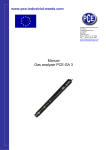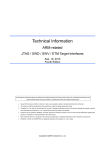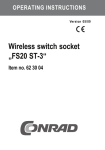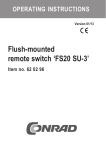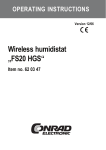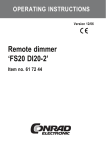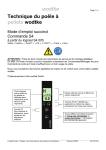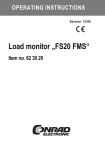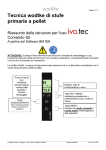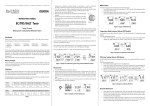Download User`s Manual Gas-Leak Detector Introduction Prescribed use
Transcript
User’s Manual Gas-Leak Detector Introduction Dear customer, We would like to thank you for your acquisition of the Gas-leak detector. You have acquired a product which is built to the latest and highest technological standards. This product fulfils the requirements of the established European and national guidelines. CE-conformity has been proven; the relevant declarations and documents are in the possession of the manufacturer. To preserve this condition and to ensure sale operation, the user must adhere to this operating manual! Prescribed use This Gas-leak detector is a very sensitive, self-sufficient warning system. The device consists of a gas sensor, an acoustic signal generator, a visual status-display and a power supply. The device responds to the following types of gas: natural gas and propane. The device serves to recognize gas leaking from small liquefied-gas containers, such as campinggas cartridges, gas lighters, gas soldering torches, etc. The device is not suitable for continuous operation, but only for short-time operation (note lifetime of battery). The device is to be considered as an aid only and must only be used for small gas containers, such as lighters, camping-gas containers etc.. If there is reason to believe that gas is leaking, especially in case of complex gas systems, such as heaters or ovens, you should not carry out the measurement yourself, but contact an expert. The device is not suitable for those types of measurements. Do not put yourself at risk. In case of leaking gas, leave everything else, especially the repair, to an expert who is familiar with the relevant dangers and regulations. The device is not designed for industrial use. Also note all other safety instructions contained in this operating manual. Safety and danger instructions An exclamation mark placed in the center of a triangle refers to important advice contained in the operating manual. Please read the complete operating manual before commissioning the product, since it contains important information on the proper operation of the device. The guarantees become invalid in the event of damage resulting from nonobservance of the operating manual! We do not accept responsibility for such damage! We accept no responsibility for property damage or personal injuries caused by improper use or non-observance of safety instructions! Furthermore, in all such cases guarantees become invalid. The unauthorized rebuilding and/or modifying of the product is not permitted, because of safety and approval reasons. Make sure that the products is commissioned properly. Adhere to the instructions in this operating manual. Never pour liquids over the gas-leak detector. This may damage the device. If this nevertheless occurs then remove the batteries. Do not expose the device to high temperatures, dampness or strong vibrations, nor to high humidity. Avoid serve mechanical stress. The gas-leak detector is equipped with highquality electronics and is, therefore, very sensitive to impact, mechanical shock etc., which may destroy the gas sensor. Furthermore, the gas sensor(1) may be damaged or destroyed by blowing strongly and directly onto it, or by wetness Handle the gas-leak detector with care. If you are not sure about the operation, safety or connection of the devices, please contact an expert. Keep the device out of reach of children. Control elements (4) (1) (2) (5) (6) (3) AAA AAA (1) Gas sensor The sensor is (7) the heart of the (10) gas-leak detector. (8)It recognizes gas (9) and transforms this information into electrical impulses gas and transforms this information into electrical impulses which ca be read out by the analysis electronics (2) Gas display LED This LED shines when the device triggers an alarm due to the detection of gas. (3) POWER display LED This LED shines when the device is switched on and the batteries still have sufficient capacity. The LED does not shines when the batteries are too low or flat. (4) STATIC display LED This LED shines as soon as the device recognizes a static discharge. (5) Circuit breaker/circuit closer(ON/OFF) This switches the device on and off. In the “ON” position the device is switched on and in the position the device is switched on and in the “OFF” position the device is switched off. (6) Carrier sling The carrier sling is intended to prevent accidental slipping of the gas-leak detector.. Fasten the carrier loop to the respective fastening eyelets at the end of the detector. (7) Cover The cover portents the sensitive gas sensor from damage. Remove the cover before operation and replace it when you have finished operating the detector. (8) Battery chamber The battery chamber serves to hold the two micro batteries which are necessary for operation. (9) Battery chamber cover (10) Static aerial Inserting the batteries and battery exchange The device may be operated only with batteries. Storage batteries are not suitable for operation. z z z Slide the battery chamber cover(9) off the device. Insert two micro batteries into the battery chamber(8). The positive pole of the batteries must point towards the gas sensor(1). Is possible, use alkaline batteries since they ensure a longer operating time. Close the battery chamber cover again. A battery exchange is necessary if the green display LED (3) does not shine after the device has been switched on, or if the device no longer responds properly. To avoid damage caused by leaking batteries, remove the battery if the device is not to be used for a long period of time. For the same reason we recommend the immediate removal of empty batteries. Environmental note! The end user is legally required to return (old battery regulation)all used batteries and storage batteries (round cells, lead acid batteries etc.); a final disposal together with domestic waste is not permitted. You can return your used batteries and storage batteries free of charge either to our branches or to the main office in Hirschau or to local disposal units(reusable waste facilities) which are obliged to accept returned batteries. Contribute to environmental protection! Commissioning and operation To ensure proper commissioning it is absolutely necessary that you read this operating manual, including the safety instructions, completely and carefully! z Remove the cover(7) z Switch on the gas-leak detector by sliding the ON/OFF button(5) to the position “ON”. z The device produces a short beep. The red display LED (2) shines simultaneously then the green LED (3) will shine. If the green LED does not shine, you will have to exchange the batteries If the device is switched on again shortly after having been switched off, the switch-on procedure may deviate from the procedure described here; the device may, for example, produce no beep tone or the red LED may not shine etc. This is why, after switching it off, you should wait 60 seconds before switching the device back on. z When the beep tone has stopped and the green display LED(3) shines, the device is ready for operation. In order to detect any possible gas leak, hold the device with the gas sensor(1) close to the object which is to be tested. z If the gas-leak detector detects leaking gas, this will be indicated by the shining of the red display LED(2). A beep tone will also be produced. The device will terminate this alarm status as soon as the concentration of gas falls below the detectable limit value. While using the gas-leak detector make sure that you pay attention to the different behaviour of different gases; liquefied gas, for example, is heavier than air and settles on the ground. This is why the highest concentration of gas is close to the ground. For more information ask at the relevant gas power plant or ask an expert. If the flow rate of the gas is too high this may damage the gas sensor. For this reason you should never place the gas sensor directly in a strong air/gas current. Static discharge z z z The STATIC display LED (4)will shine for a short period of time as soon as the device detects a static discharge. A static charge from the human body is often created in a dry environment and when synthetic materials are rubbed. This charge can discharge with a spark while touching an earthed object, for example a heater. At the bottom of the device, a small wire can be seen which projects out of device. This wire is the “aerial” which is necessary for the detection of the discharge. Before a gas-detection operation, touch the small wire at the bottom of the device and touch an earthed object, for example a heater, with your other hand. If you are statically charged, the STATIC display LED(4) will shine for a short period of time. This measurement must not be carried out in the same room in which the gas detection is carried out, since leaking gas may be ignited by the sparks created. The STATIC test should always be carried out before a gas-detection operation. If there are strong charges, a gas-detection operation should not be carried out, since the static charge is renewed when a person moves around and new sparks may be created during the gas-detection operation. Alarm If the detector produces an alarm(beep tone and red LED shines), gas is leaking from the object. Depending on the amount of leaking gas, you should immediately open all windows and doors, and avoid both open fire and the creation of sparks. Do not operate electrical switches. Leave the room. If possible, turn off the gas supply. You should immediately inform an expert about leaking gas systems. Do not try to deal with the fault yourself! Inspecting the gas-leak detector Hold a gas lighter close to the gas sensor(1). Let gas leak out of the lighter without the flame of the lighter burning. The gas-leak detector should now produce a beep tone and the red display LED(2) should shine. If this is not the case, either the batteries are empty or the gas-leak detector is defective. False alarm Due to the high sensitivity of the detector, a false alarm due to other gaseous materials such as aerosols( hair sprays, propellant gas, cigarette smoke etc.) cannot be excluded. Maintenance and disposal Maintenance Check the gas-leak detector regularly for technical reliability. It can be assumed that safe operation has become impossible, if: z the device shows visible damage z the device was stored under unfavourable conditions for a long period of time z it was exposed to extraordinary stress caused by transport z the test function described above no longer runs correctly. Use a sort, dry cloth or brush to clean the outside of the device. Never use aggressive cleaning agents or chemicals, since they may damage the housing or impair the function of the device. Avoid touching the gas sensor(1) or cleaning it in any way. Apart from the battery chamber, do not try to open the housing. Disposal Dispose of the unserviceable device according to legal and statutory regulations. Technical data Operating voltage……:3VDC (2x micro batteries, alkaline) Power consumption…:approx.200mA Types of gas to which the device responds: Propane and natural gas (for the most part a mixture of hydrocarbons, natural gas, normally consisting of 80-95% methane+ various other gases, such as carbon dioxide, carbon monoxide and helium) Sensitivity: Min Max Propane 500ppm 6500ppm Natural gas 1000ppm 6500ppm Operating life………….depending on type of battery used approx. 4 hours. Weight…………………46g Dimensions…………….180mm(L) x21mm(diameter) Surrounding conditions Working temperature :10 to 50 Relative humidity….. :<95%(not condensing) Storage temperature.:5 to 55





